SOW NOW?
Next Year’s ‘Chokes
Ahh, such a leisurely time of year to sow seeds. And for some of them, I don’t care if they don’t sprout for months. You might wonder: Why sow now; why so laid back?
I’ll start with artichoke, from whose seeds I did want to see sprouts soon. And I did. The seeds germinate readily. Right now, a few small seedlings are growing, each in its own “cell” of a seed flat, enjoying the cool, sunny weather.
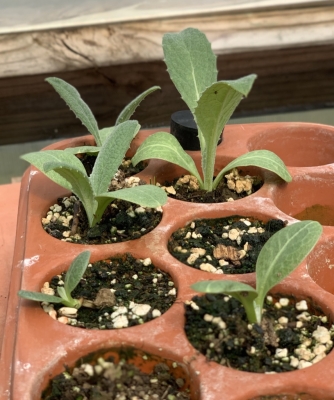
Artichoke is a perennial whose natural life cycle is (usually) to grow leaves its first year, then edible buds its second year and for a few years hence. Especially in colder regions, artichokes can sometimes grown from seed like annuals, with a wrinkle.
To make that transition from growing only leaves to growing flower buds, the plants need to get vernalized, that is, to experience some winter cold. Except that winter cold here in the Hudson Valley (and everywhere else colder than Hardiness Zone 7) will do the plants in. So we cold-climate gardeners need to trick the plants into feeling like they experienced winter cold, just not our winters’ depth of cold.
When growing artichokes like annuals, from seed sown in spring, you make “winter” by exposing the young, growing seedlings to cool, but not frigid, temperatures (32-50°F) for a couple of weeks. The problem with this method is that the plants are fairly small when they get this signal that “winter” is over. In my experience, these small plants make commensurately small buds for harvest.
I’m lucky enough to have a greenhouse that gets very cool in winter, but not below freezing. My young artichoke plants will continue to grow very large though the very extended “autumn” weather in the greenhouse. In midwinter, they should get plenty of chilling. Come spring, after frost danger is past, I’ll plant out the large plants to, I hope, make large, fat buds.
I got this idea from growing cardoon, which is essentially the same as artichoke, except it’s grown for its large leaf stalks.

Or it’s grown as a flower, in which case it would require the same conditions as artichoke to make flowers. I don’t like cardoon as a vegetable but do like it as a flower, so last year, around now, I sowed cardoon seeds and grew the seedlings in the greenhouse just as I’ve described for artichoke. The result was big, fat, beautiful, blue flowers. I expect the same, except I’ll harvest the artichoke buds before they open.
Actually, I grew two cardoon plants, and for some reason one of them grew only leaves all summer, and is still growing them, the olive-green leaves each rising from ground level in a four-foot-high-whorl.
More Hucks’
A couple of months ago I collected huckleberry seeds from my huckleberry plant and sowed them. As expected, they still haven’t sprouted. They weren’t expected to sprout, at least not until they were “stratified.”
Like artichoke, huckleberry (Gaylussaccia baccata) needs to feel that winter is over, in this case before its seeds will sprout. Stratification, as this cold exposure is called, prevents small seedlings from being killed by winter cold after sprouting in late summer or autumn.
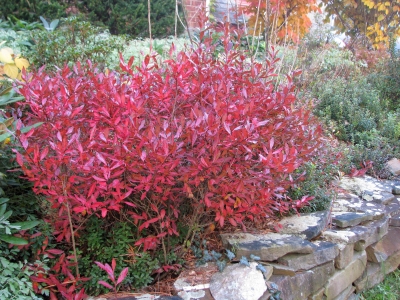
My huckleberry plant in fall
Again, it’s a certain duration of cool (32-50°F) temperatures that do the trick. Under natural conditions, these chilling requirements are fulfilled in late autumn and/or in spring. In this case, colder temperatures would do no harm, but would not put any hours into the “chilling bank.” Once the “chilling bank” has been filled, the seeds await warm enough temperatures to sprout.
(For more details and wrinkles about seed germination, see my latest book, The Ever Curious Gardener: Using a Little Natural Science for a Much Better Garden.)
The pot of huckleberry seeds has been sitting outdoors, covered, since they were sown. If I want earlier sprouting, I’ll bring the pot into the greenhouse in winter.
Ramping Up
I collected seeds from my ramp plants about a month ago with an eye to increasing my holdings. You guessed it: Ramps also need cold. But given mere stratification, the seed will not germinate. The behavior of ramp seeds is a little different from huckleberry seeds in that ramp seeds have a double dormancy.
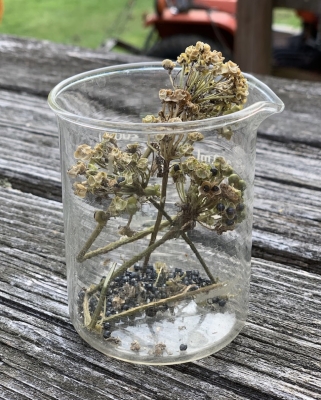
Roots need to grow before the shoots will sprout. That first stage requires a couple of months or so of warmth. Only after then can the second stage, shoot growth, begin, except that won’t occur until after a stratification period, with cool temperatures, again between 32-50°F.
Under natural conditions, ripe ramp seeds get their warm period before winter sets in and then are ready to sprout in spring. But further north, where seeds ripen later, that first stage, to get root growth underway, is delayed until the summer after the seeds drop. In that case, sprouts don’t poke above ground until their second spring.
I don’t want to wait that long so I sowed my ramp seeds in a seed flat which I’m keeping in a warm place for a couple of months. After that, I’ll move the flat to cooler temperatures. And then, come spring, sprouts — I hope.
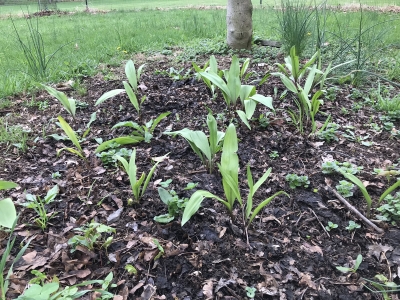
My ramps mother plants

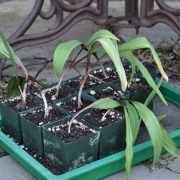
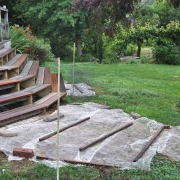
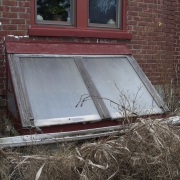


Thanks for sharing your knowledge of ramps and how to propagate. I believe that, while they can still be found, many colonies have disappeared due to over-harvesting or perhaps habitat disruption. Maybe if people are shown how to establish their own colony they will not be so tempted to take them from the wild.
I am currently at work on a recipe project for permaculture and wild edibles, as it seems some people have knowledge that a plant is edible but have no idea how
to harvest appropriately, preserve them or use them in a tasty recipe. Do you use your ramps just like garlic and onions? Have you tried drying them? I’d be interested to know. I am working on recipes for Autumn Olive, which is considered invasive in my region but has edible fruits loaded with vitamins. I like the flavor but the preparation is labor intensive.
Good ideas. I’ve just added steamed or sauteed ramps leaves to other cooked vegetables. I haven’t had enough yet to try various ways of using it.
I’m very interested in recipes for using some of the uncommon fruits I wrote about in my book Uncommon Fruits for Every Garden, including autumn olive. For gumis, which are similar, I made a delicious leather. If anybody has good recipes for any of the fruits, I’d love to know them. The fruits include: pawpaw, persimmon, autumn olive, Russian olive, gumi, medlar, juneberry, lowbush blueberry, seaberry, huckleberry, nanking cherry, beach plum, lingonberry, red currants, black currants, gooseberries, Asian pears, jostaberry, maypop, che, cornelian cherry, kiwifruits, alpine and musk strawberries.
Regarding the above post and using some of these small berries (with seeds!), I make shrubs. i am far too busy (lazy) to pit tiny fruits, so I mash them and macerate them with organic sugar and then turn them into shrubs aka sipping vinegars. They are delicious and are a wonderful (and historical!) way of preserving these special fruits.
This is great info about artichokes and cardoons! I’m attempting my first crop this year! I just started my seeds though, it looks like you start yours a lot earlier!
I started mine in late summer, and they spent winter in my cool temperature greenhouse.